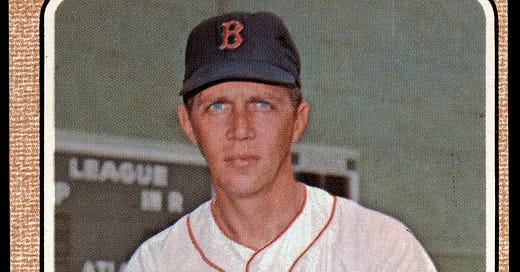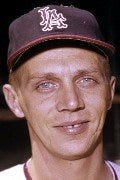MSL to MLB: Barrington-Wauconda Connection to MLB Pitcher Dan Osinski
Move Led to Six Conference Championships for Three-Sport Star at Barrington
We referred to Barrington’s nonconference boys basketball trip to Wauconda late Friday afternoon as the “Dan Osinski Game” for the big-league pitcher who attended both high schools.
And the Osinski game was quite a trip as I can’t recall many I’ve witnessed with five players scoring 20 points. Alec Schmidts (25), Nick Peipert (24) and Oliver Gray (22) led the Broncos to an 88-71 victory as Cayden Mudd and Braeden Carlsen scored 24 apiece for the Bulldogs.
The two schools are separated by only 10 miles and Osinski went to Wauconda his first two years of high school. His family moved to Barrington in September before his junior year and he went on to star in football, basketball and baseball at the school.
Osinski, who died in 2013 just two months before his 80th birthday, was spotlighted in “The Unofficial History of Barrington High School Boys Basketball” by retired athletic director and boys basketball head coach Mike Obsuszt for his eight-year MLB career as a pitcher. It included a World Series appearance and connections to legends such as Hall of Famers Willie Mays, Hank Aaron and Ted Williams and broadcaster Howard Cosell.
It all started in an area now considered the northwest suburbs of Chicago but post-World War II would be viewed as farmland on the way toward Wisconsin. In September 1949, Osinski went out for football for the first time and played some running back for an 8-0 Barrington team that won the second of four consecutive Northwest Conference titles.
From there he joined a basketball team that would win the third of eight consecutive conference titles. Osinski was an honorable mention all-NWC pick and his tiebreaking free throw with five seconds left gave Barrington a 34-33 victory over rival Palatine and a 14-0 NWC finish.
“Baseball wasn’t my main sport,” Osinski said in his Society for American Baseball Research (SABR) biography written by Ron Anderson. “When I was in high school it was basketball and football.”
But the kid wasn’t tagged “No Hit” Dan Osinski by G.A. McElroy, the legendary Paddock Publications columnist and area educator and coach, for no reason. Barrington tied for the NWC baseball title as Osinski ended the spring with a no-hitter against his old school and started the summer with another no-hitter.
He would use his strong arm at quarterback in the fall and earn all-NWC honors as Barrington went 9-0 in the program’s first year under legendary coach Tom Frederick. He continued to torment Wauconda with 4 touchdown passes in a 47-7 romp and his TD pass in the final minutes to star classmate Steve Roake was the difference in a crucial 13-7 win over Grant.
Then it was on to basketball where Osinski and Roake earned first-team all-NWC honors and were all-regional picks as Barrington cruised to conference and district titles and its first regional crown. The Bronchos (as the nickname was spelled then) won their sectional semifinal but 15 points apiece from Osinski and Roake weren’t enough to overcome Oak Park and 6-foot-10 Jim Duncan 61-56. At the time, all 16 sectional champions advanced to the state tournament in Champaign and McElroy believed the 24-4 Bronchos were better than six of them.
Osinski continued to back up McElroy’s nickname by no-hitting Northbrook and throwing 7 no-hit innings in a scoreless game called because of rain. Barrington won the NWC title as Osinski finished with four consecutive shutouts where he allowed only 8 hits. He would also pitch a 1-hitter with 16 strikeouts against Palatine in the summer.
His plan to go to the U.S. Naval Academy fell through after a failed physical so the 17-year-old Osinski was signed by the Cleveland Indians for $4,000 after a tryout. In his second year at Class C Sherbrooke (in Quebec) he went 18-7 and his roommate in stops at Keokuk (Iowa), Reading (Pennsylvania) and Tulsa (Oklahoma) was Roger Maris, who hit a then-record 61 homers with the 1961 Yankees.
A long-term bout with mononucleosis and spending 1957 and 1958 in the Army put Osinski at a career crossroads and he said “I was just thinking about hanging it up” in his SABR biography. But he went to spring training in 1959 with the White Sox and got a minor-league shot where he focused on being a relief pitcher. After a strong spring in 1962 with the Kansas City A’s he finally made it to the bigs at age 28 - but only for 4 relief appearances before he was sent to Triple-A.
His sale to Portland and a surprising “shot and a beer” led to his extended big-league run. Osinski, who was nicknamed “The Silencer,” made the Pacific Coast League All-Star team but wasn’t supposed to pitch in its exhibition game against the Los Angeles Angels. His younger brother came in for the game and, according to Osinski’s SABR bio, “we had a couple of beers, played golf that day and I went to the ballpark.”
He was sitting in the bullpen when he got a call to see if he could pitch. “And that was my big break, really,” Osinski told Anderson with a laugh. “I said, ‘Yes, I’m loose. I had a couple of beers, is that all right?’” It certainly was as Osinski got 4 strikeouts in 1⅔ innings for the relief victory and an impressed Angels general manager Fred Haney acquired him. Osinski would have a nice three-year run with them, where he also showed he wasn’t afraid to protect his hitters, before he was traded to the Milwaukee Braves after the 1964 season.
Osinski pitched in a career-high 61 games in the Braves’ last year in Milwaukee before they moved to Atlanta. One of those games with future home-run king Henry Aaron would be memorable because manager Bobby Bragan ordered Osinski to throw all spitballs and make it obvious because a pitcher for the San Francisco Giants was doing the same.
“I only got called on it, I think twice and (the umpires) said, ‘just wipe it off,’” Osinski said.
But the next day Cosell, best known for his coverage of boxer Muhammad Ali and Monday Night Football, and Bragan convinced a reluctant Osinski to demonstrate how to throw the spitter for a national TV audience. Osinski was concerned the exposure of something illegal could damage his career, but it didn’t and a trade to Boston in December 1965 led to a different kind of exposure.
Retired Red Sox Hall of Famer Ted Williams said in the spring of 1966 of Osinski, “I’d hate to hit against that guy. What a motion he’s got. He’s got to help this club.” Osinski did in a big way in 1967 as the “Impossible Dream” Red Sox vaulted from ninth place in the American League to emerging as champions from a tight and tense four-team pennant race that was decided on the final day of the regular season. He pitched in 2 games in the 7-game World Series loss to the St. Louis Cardinals.
Despite his success he was released by the Red Sox just before the 1968 season. He hooked on with his hometown White Sox again and spent the season in Triple-A Hawaii before making it back to the big leagues in 1969. Osinski went 5-5 with a 3.56 ERA in 51 games for a 68-94 team in his only season on the South Side before he was on the move again.
But after spending most of 1970 in the minors, except for 3 appearances with the Houston Astros, Osinski decided to settle into a post-baseball life instead of trying to hook on with the San Diego Padres. His final big-league pitch was memorable because he got Mays, who hit 660 career homers, to ground out. He went 29-28 with 18 saves and a 3.34 ERA in 324 big-league games and had a minor-league record of 108-81 in 460 games.
Osinski went into banking, was involved in the ownership of a restaurant in the south suburbs and also worked in sales for a used car dealer in Arizona before he passed away. He made one brief “return” to the baseball spotlight in 1976 when he modeled White Sox owner Bill Veeck’s unique new collared uniforms along with ex-Sox players Bill “Moose” Skowron, Moe Drabowsky, “Jungle” Jim Rivera and Dave Nicholson.
Not bad for someone who believed he was better suited for football and basketball uniforms at Barrington.






